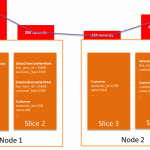AWS Big Data Blog
Amazon Redshift Engineering’s Advanced Table Design Playbook: Table Data Durability
Part 1: Preamble, Prerequisites, and Prioritization
Part 2: Distribution Styles and Distribution Keys
Part 3: Compound and Interleaved Sort Keys
Part 4: Compression Encodings
Part 5: Table Data Durability (Translated into Japanese)
In the fifth and final installment of the Advanced Table Design Playbook, I’ll discuss how to use two simple table durability properties to squeeze even more performance out of your Amazon Redshift configuration.
Limiting Automated Backups
With automated backups, Amazon Redshift will frequently push incremental block changes to Amazon S3. These automated backups are triggered based on a threshold of time or blocks changed. This approach makes possible recovery features such as snapshot and table level restore operations.
The actual cost of the automated backup is generally insignificant. However, because it transfers data blocks to S3 it can potentially affect your clusters’ throughput to S3 for workloads that constantly perform large COPY or UNLOAD operations. To reduce the cost of these automated backups, we can use the table property BACKUP NO for tables that don’t contain data to store durably in S3. Some tables where you can use this property are these:
- Tables that are populated with easily recreated data
- Tables containing data that is transient or often changing in nature
- Tables that are populated with unimportant or experimental data
We use this property to achieve two things:
- Preventing inconsequential block changes from triggering frequent automated backups
- Reducing quantity of blocks transferred to S3 during backups, to reduce backup duration
Note: Tables defined as temporary inherit this property by default, because these tables are cleaned up at the end of the session in which they were created.
Reducing Synchronous Data Replication
By default, multinode Amazon Redshift configurations automatically store redundant copies of table data on other nodes in the same cluster, so we can tolerate multiple disk and node failures. As with all synchronous data replication, some overhead is associated with the process. For temporary tables, this replication process doesn’t occur because the system makes the assumption that the data is truly transient. Additionally, blocks associated with temporary tables don’t count toward the threshold which triggers automated backups. Thus, by using temporary tables for truly transient data we can also avoid triggering backup processes and improve the rate at which the automated backup processes complete—just as we did with the BACKUP NO option.
Because temporary table data is not mirrored, the transactions that commit temporary table data are less expensive than those that commit permanent table data. This functionality means you can significantly reduce cluster overhead by using temporary tables where they are appropriate. Examples include scenarios where table data only needs to be accessible for a single session and is truly transient in nature.
You can identify the tables in a cluster that are currently using either of these table properties by using this query:
SELECT DISTINCT id, name, temp, backup
FROM stv_tbl_perm
WHERE backup=0 ORDER BY 1;Next Steps
Depending on your unique data durability and retention requirements, these options might not be appropriate for you—and that’s okay. Out of the topics we’ve discussed throughout this blog series, these particular optimizations result in the least significant overall improvement to cluster performance. However, in an environment that is being optimized from top to bottom, this is the final table design concept you can use for a performance gain.
Amazon Redshift Engineering’s Advanced Table Design Playbook
Part 1: Preamble, Prerequisites, and Prioritization
Part 2: Distribution Styles and Distribution Keys
Part 3: Compound and Interleaved Sort Keys
Part 4: Compression Encodings
Part 5: Table Data Durability
About the author
 Zach Christopherson is a Palo Alto based Senior Database Engineer at AWS. He assists Amazon Redshift users from all industries in fine-tuning their workloads for optimal performance. As a member of the Amazon Redshift service team, he also influences and contributes to the development of new and existing service features. In his spare time, he enjoys trying new restaurants with his wife, Mary, and caring for his newborn daughter, Sophia.
Zach Christopherson is a Palo Alto based Senior Database Engineer at AWS. He assists Amazon Redshift users from all industries in fine-tuning their workloads for optimal performance. As a member of the Amazon Redshift service team, he also influences and contributes to the development of new and existing service features. In his spare time, he enjoys trying new restaurants with his wife, Mary, and caring for his newborn daughter, Sophia.
Related
Top 10 Performance Tuning Techniques for Amazon Redshift (Updated Nov. 28, 2016)
